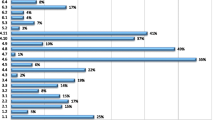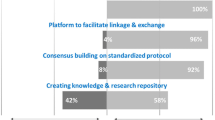Abstract
Objectives
The aim of this study was to determine how tobacco control interest groups influence tobacco policy decision-making through submissions and presentations to parliamentary committees.
Methods
A qualitative content analysis was used to examine the presentations and submissions on tobacco-related legislation made to parliamentary committees between 1996 and 2004. The sample was identified from the public list of tobacco-related bills tabled in both the House of Commons and the Senate; the Government of Canada website and LEGISinfo were used to determine which committee reviewed the relevant bill. Committee clerks were asked to send submissions and presentations related to specific bills identified through LEGISinfo. Submissions and presentations were scanned and entered into QSR N6 software for coding. The coding instrument was adapted from previous studies employing qualitative content analysis. Montini and Bero’s recommendations were used to evaluate the submissions and presentations.
Results
Tobacco control interest groups did present scientific evidence to support tobacco control. However, they underused credible witnesses to present information at meetings. The topics presented by tobacco control interests groups were usually relevant to the bill being discussed.
Discussion
Tobacco control interest groups employed some of the strategies suggested by Montini and Bero in their attempt to influence parliamentary committees through submissions and presentations. They did include scientific evidence in their submissions; however, they could improve their strategies in the area of using credible witnesses, such as scientists and medical experts. Incorporating Montini and Bero’s recommendations into lobbying efforts may increase success in influencing committees.
Résumé
Objectifs
Déterminer comment les groupes d’intérêts antitabac influencent les décisions politiques liées au tabagisme dans leurs présentations aux comités parlementaires.
Méthode
Nous avons analysé le contenu qualitatif des présentations sur la législation antitabac faites devant les comités parlementaires entre 1996 et 2004. Notre échantillon était extrait de la liste publique des projets de loi sur le tabac déposés à la Chambre des communes et au Sénat; pour déterminer quels comités avaient examiné ces projets de loi, nous avons consulté le site Web du gouvernement du Canada et LEGISinfo. Nous avons demandé aux greffiers des comités de nous envoyer les présentations liées aux projets de loi trouvés dans LEGISinfo. Ces documents ont été numérisés et saisis avec le logiciel QSR N6 pour être codés. Notre outil de codage était inspiré d’études antérieures reposant sur des analyses de contenu qualitatives. Pour évaluer les présentations, nous avons utilisé les recommandations de Montini et Bero.
Résultats
Les groupes d’intérêts antitabac ont fourni des preuves scientifiques à l’appui de la lutte contre le tabagisme. Cependant, ils auraient pu faire davantage appel à des témoins crédibles pour présenter l’information lors des réunions. Les thèmes abordés par les groupes d’intérêts antitabac étaient généralement en rapport avec le projet de loi débattu.
Discussion
Les groupes d’intérêts antitabac ont employé certaines des stratégies suggérées par Montini et Bero pour influencer les comités parlementaires dans leurs présentations. Ils ont fourni des preuves scientifiques dans leurs documents, mais ils auraient pu améliorer leurs stratégies en faisant appel à des témoins crédibles (scientifiques ou experts en médecine). En appliquant les recommandations de Montini et Bero aux activités de lobbying, ils pourraient accroître leur influence sur les comités.
Similar content being viewed by others
References
Oandasan IF. Health advocacy: Bringing clarity to educators through the voices of physician health advocates. Acad Med 2005;80(10):S38–S41.
Luke DA, Krauss M. Where there’s smoke there’s money: Tobacco industry campaign contributions and U.S. congressional voting. Am J Prev Med 2004;27(5):363–72.
Givel M, Glantz SA. Tobacco lobby political influence on US state legislatures in the 1990s. Tobacco Control 2001;10(2):124–34.
Sebrie EM, Barnoya J, Perez-Stable EJ, Glantz SA. Tobacco industry successfully prevented tobacco control legislation in Argentina. Tobacco Control 2005;14(5):e2.
Knight J, Chapman S. Asia is now the priority target for the world anti-tobacco movement: Attempts by the tobacco industry to undermine the Asian anti-smoking movement. Tobacco Control 2004;13(Suppl 2):ii30–6.
Givel MS, Glantz SA. Failure to defend a successful state tobacco control program: Policy lessons from Florida. Am J Public Health 2000;90(5):762–67.
Shillis JA, Hall BA, Sneden GG, Gottlieb NH. Keeping the focus on public health: The struggles of a tobacco prevention task force. Health Educ Behav 2003;30(6):771–88.
Cohen JE, Goldstein AO, Flynn BS, Munger MC, Gottlieb NH, Solomon LJ, et al. State legislators’ perceptions of lobbyists and lobbying on tobacco control issues. Tobacco Control 1997;6(4):332–36.
Roth AL, Dunsby J, Bero LA. Framing processes in public commentary on US federal tobacco control regulation. Soc Stud Sci 2003;33(1):7–44.
Montini T, Mangurian C, Bero LA. Assessing the evidence submitted in the development of a workplace smoking regulation: The case of Maryland. Public Health Rep 2002;117(3):291–98.
Montini T, Bero LA. Policy makers’ perspectives on tobacco control advocates’ roles in regulation development. Tobacco Control 2001;10(3):218–24.
Durrant R, Wakefield M, McLeod K, Clegg-Smith K, Chapman S. Tobacco in the news: An analysis of newspaper coverage of tobacco issues in Australia, 2001. Tobacco Control 2003;12(Suppl II):ii75–81.
Wenger L, Malone R, Bero L. The cigar revival and the popular press: A content analysis, 1987–1997. Am J Public Health 2001;91(2):288–91.
Bero LA, Montini T, Bryan-Jones K, Mangurian C. Science in regulatory policy making: Case studies in the development of workplace smoking restrictions. Tobacco Control 2001;10(4):329–36.
Author information
Authors and Affiliations
Additional information
Acknowledgements: RH was supported through an Ashley Studentship for Research in Tobacco Control from the Ontario Tobacco Research Unit. AK holds a career scientist award from the Ontario Ministry of Health and Long-Term Care.
Rights and permissions
About this article
Cite this article
Hastie, R.E., Kothari, A.R. Tobacco Control Interest Groups and Their Influence on Parliamentary Committees in Canada. Can J Public Health 100, 370–375 (2009). https://doi.org/10.1007/BF03405273
Received:
Accepted:
Published:
Issue Date:
DOI: https://doi.org/10.1007/BF03405273




